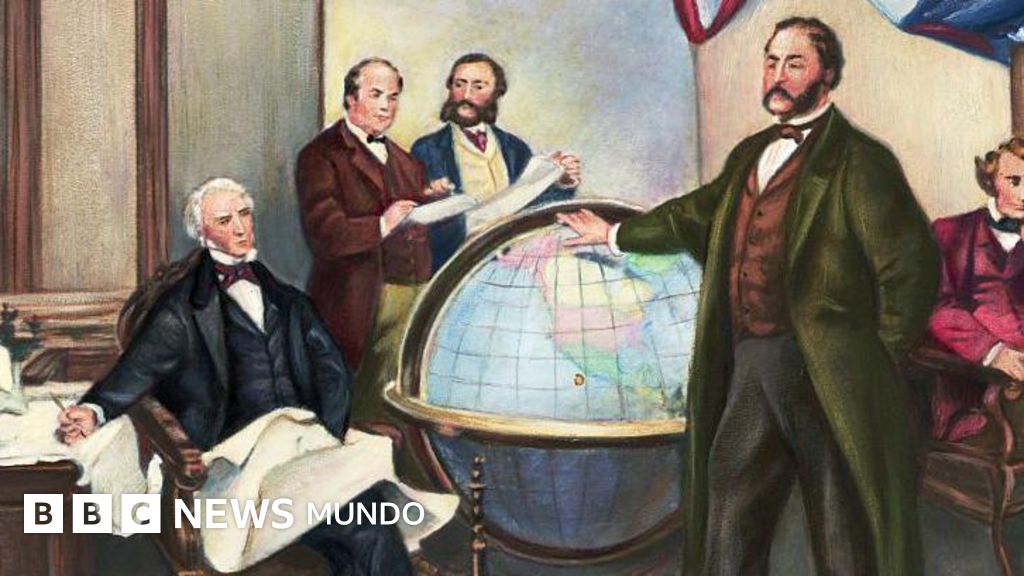

Image source, Getty Images
-
- Author, Waleh Barran
- Author's title, World BBC service
- Author, Maria Zaccaro
- Author's title, World BBC service
Friday's summit in Alaska between the United States and Russia to discuss the end of the war in Ukraine is possibly one of the most significant diplomatic events in recent years.
And the location of the meeting has a historical relevance.
Presidents Donald Trump and Vladimir Putin will meet in American territory in Anchorage, the largest city in Alaska.
If the meeting had taken place in the same place about 150 years ago, it would have been in Russian territory.
This is because Alaska, which is now the largest state in the US -a fifth of the country's total area -belonged to Russia in the past.

Image source, Hulton Archive/Getty Images
A “quite logical” location
Located in the northwest end of North America, Alaska is separated from Russia by the Bering Strait, which measures just over 80 kilometers at its narrowest point.
When Trump announced that the summit would be held in Alaska, the Russian presidential assistant Yuri Ushakov said that it seemed “quite logical” that the Russian delegation “simply fly over the Bering Strait and that such an important and expected summit of the leaders of both countries is celebrated in Alaska.”
However, the historical links between Russia and Alaska date back to the early 18th century, when the indigenous people of Siberia spoke for the first time of a vast land located east.

An expedition led by the Danish navigator Vitus Bering discovered that the new lands were not connected to the Russian continent. But due to the dense fog, the expedition failed.
In 1741, another expedition, also led by Bering, did succeeded and men were sent to those lands.
Subsequently, several commercial expeditions were carried out, and when they took Russian otter skins to Russia, the door opened to a lucrative trade of skins between Europe, Asia and the Pacific coast of North America.
However, in the nineteenth century, British and American skins merchants became fierce competitors of the Russians.
Although the bitter rivalry was resolved in 1824, when Russia signed separate treaties with the US and Great Britain, the almost extinction of marine otters and the political consequences of the Crimean War (1853-1856) made Russia be willing to sell Alaska to the US.
A “madness”
William Seward, then the US Secretary of State, led the negotiations for the purchase of land and achieved a treaty with the Russian tsar Alexander II.
After a great opposition, the US Congress approved Seward's formal offer of US $ 7.2 million, and on October 18, 1867 the US flag was raised in Sitka, the then capital of Alaska.
Initially, Alaska's purchase was qualified as Seward's “madness” by critics, convinced that the territory was a desolate immense that had no greater economic utility.
Added to inflation, US $ 7.2 million paid by the US would be just over US $ 150 million, a remarkably low price for which today is the largest state in the US.
The purchase of Alaska added more than 1.5 million square kilometers to the country, or about 151 million hectares of land.
But of course, Alaska is much more than simple land. It is also a huge deposit of natural resources. They had not spent two decades of the purchase of Alaska in Washington when a gold fever exploded.
And in the mid -twentieth century, the oil companies found huge deposits in the north of the state, which since then have been exploited intensively. It is such the oil wealth of Alaska that the government gives every year to the inhabitants of the State, for the mere fact of living there, a bonus that can reach thousands of dollars.
Seward's initiative was gratifying and, in 1959, Alaska officially became the 49th state of the United States.
Alaska is today a powerful economy with almost 750,000 inhabitants and a GDP of US $ 70,000 million annually. In other words, every year it produces more than 400 times what Russia obtained in total by selling the territory in the nineteenth century.

Image source, Hasan Akbas/Anadolu via Getty Images
Military power
Behind the sale of Russia there was a strategic and military interest.
It is said that one of the reasons why the Tsar sold Alaska is that he feared that Great Britain, at that time the great world superpower and the nation that controlled the west of Canada, could have expansionist designs about Russia that would make Alaska an attractive prey.
He could not know then that almost a century later, in 1945, at the beginning of the Cold War between the United States and the Soviet Union, Alaska would become an invaluable position of advanced military that would put American troops, radars and planes at the gates of the Russian territory.
So the sale of Alaska in Russia in 1867 seems to be, seen with the lenses of modernity, a calamitous commercial and strategic error on the part of the tsar.
Alaska, an important source of environmental resources, today has more than 12,000 rivers and a large number of lakes.
Its capital, Juanneau, is the only US capital that can only be reached by boat or plane. Lake Hood, in Anchorage, is one of the most busy hidbax bases in the world, with about 200 daily flights.
Trump and Putin will meet at the Joint the Mentorf-Richardson, the largest military installation in the state. With 25,900 hectares, it is a key point of military preparation in the Arctic for the US
This is not the first time that Alaska stars in an American diplomatic event. In March 2021, Joe Biden's new diplomatic and national security team met with his Chinese counterparts in Anchorage.
No official details of the summit have been revealed, but the White House said that the conversations in Alaska would be an “listening exercise” for Trump and would give the US president “the best indication on how to put an end to this war.”

Subscribe here To our new newsletter to receive every Friday a selection of our best content of the week.
And remember that you can receive notifications in our app. Download the latest version and act.






